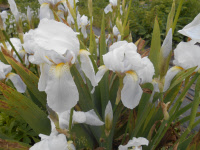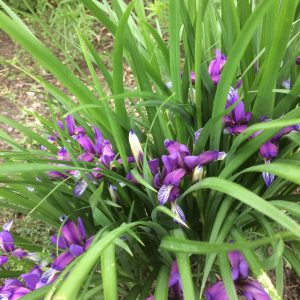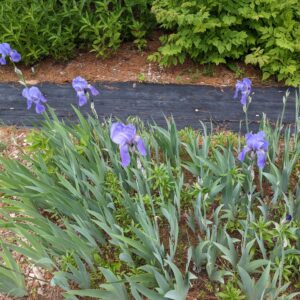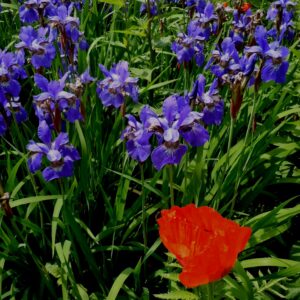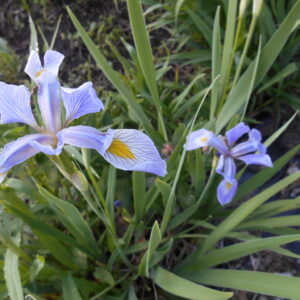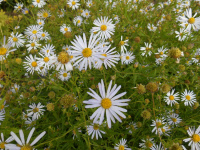Our Plants
Showing 329–336 of 587 results
-
Iris florentina Florentine iris, White flag Z 3-9
Sweetly fragrant, tall, icy blue-white iris with pale yellow signal on the fall, flowering in June
Sweetly fragrant, tall, icy blue-white iris with pale yellow signal on the fall, flowering in June
Size: 24-30” x 18-24”
Care: sun in moist well-drained soil. Plant with rhizome tops above soil.
Native: Italy and southern France
Wildlife Value: welcomes bees with easy access to pollenIris is named after the Greek goddess who accompanied the souls of women to the Elysian fields by way of the rainbow. Her footprints left flowers the colors of the rainbow. Iris means “eye of heaven.” The iris is the flower of chivalry, having “a sword for its leaf and a lily for its heart.” Ruskin. At least 2000 years old, this was identified by Dioscorides in De Materica Medica for medicinal use around 70 A.D. English herbalist John Gerard grew it by 1596. Grown in the Eichstätt Garden, the garden of Johann Konrad von Gemmingen, prince bishop of Eichstätt in Bavaria, c. 1600. Grown at America’s 1st botanic garden, Elgin Botanic Garden 1811. Its rhizome is the source of dried orris root. Dig in late summer, peel, chop, dry, age, and then grind into a powder which is a scent fixative for perfumes and potpourris and flavoring for Chianti wine. Orris root has a violet-like aroma. Add powder directly to potpourris. Mix with oil prior to adding to perfumes.
-
Iris graminea Grass-leaved iris, Plum-scented iris Z 4-8
Charming beardless spuria iris of purple styles, violet falls and ivory hafts with purple veins, blooming in June below the top of its grass-like foliage
Charming beardless spuria iris of purple styles, violet falls and ivory hafts with purple veins, blooming in June below the top of its grass-like foliage
Size: 9-16” x 9-16”
Care: sun to part shade in moist well-drained soil
Native: from Spain to Russia & Caucasus in Asia. But now endangered in Czechoslovakia and extinct in Germany.
Wildlife Value: attracts hummingbirds, bees, and butterflies. Deer and rabbit resistant.
Awards: Royal Horticultural Society Award of Garden Merit.Graminea means grass. Common name of Plum-scented for its fruity, plum fragrance. In gardens since at least 1568. Planted at Cambridge Botanic Garden in 1733.
-
Iris missouriensis Western blue flag, Rocky Mountain iris Z 3-8
In spring variegated, violet blue iris flowers - 6 perianth segments, 3 spreading to reflexed falls with a dark yellow-orange stripe down the middle with blue lines on a white background, & 3 purple standards.
In spring variegated, violet blue iris flowers – 6 perianth segments, 3 spreading to reflexed falls with a dark yellow-orange stripe down the middle with blue lines on a white background, & 3 purple standards.
Size: 12-24” x 9-12”
Care: sun to part shade in moist well-drained to moist soil. Divide regularly.
Native: Alberta and British Columbia, from Minnesota to Washington south to California east to New Mexico
Wildlife Value: Deer resistant. Attracts hummingbirds, provides pollen to bees.Named for the Missouri River although ironically Lewis collected it along the Blackfoot River in today’s Montana on July 5, 1806.
Paiute Indians of eastern California and southeastern Oregon made ear drops to remedy earaches with a decoction if the Iris roots. -
Iris pallida Grape iris Z 3-8
Blooms smell exactly like sweet grape soda - violet blue bearded iris in spring
Blooms smell exactly like sweet grape soda – violet blue bearded iris in spring
Size: 10-14” x 8-12”
Care: sun to part shade in moist well-drained soil. In July-August lift & divide every 2 to 3 years; discard mushy rhizomes.
Native: Europe
Wildlife Value: Deer and rabbit resistant.English herbalist John Gerard (1549-1612) called it “the great Floure de-luce of Dalmatia” and praising its “exceedingly sweet” scent, 1597. Grape soda had yet to be created.! Was this the soda’s inspiration? Dried rhizomes used as a fixative to preserve fragrances in powders, perfume, and gin. Peel off outer skin of rhizomes and dry tor up to five years for this.
-
Iris pumila Dwarf iris Z4-8
Natural hybrid created this tiny, purple bearded iris blooming in early spring bearing year-long green-grey sword-shaped leaves. Spreads to form large, tight clumps.
Natural hybrid created this tiny, purple bearded iris blooming in early spring bearing year-long green-grey sword-shaped leaves. Spreads to form large, tight clumps.
Size: 6-8” x spreading.
Care: sun in well-drained to moist well-drained soil
Native: Eastern Europe
Wildlife Value: deer resistantIn gardens before 1753
-
Iris siberica Siberian Iris Z 4-9
sword shaped leaves with blue, purple or lilac Iris flowers
Narrow, sword shaped leaves with blue, purple, or white Iris flowers in June.
Size: 3-4' x S 12" and spreading
Care: Full sun moist well-drained soil. Deer resistant, Walnut toxicity resistant and drought tolerant.
Native: Eastern Siberia
Awards: England's Royal Horticultural Society Award of Merit.Iris is named after the Greek goddess who accompanied the souls of women to the Elysian Fields by way of the rainbow. Her footprints left flowers the colors of the rainbow. Iris means the “eye of heaven.” The iris is the flower of chivalry, having “a sword for its leaf and a lily for its heart.” Ruskin. Siberian Irises first cultivated in European gardens in the 1500’s. Blue Siberian Iris was introduced to the U.S. in 1796. Cultivated by Washington at Mount Vernon.
-
Iris versicolor Blue flag Z 3-9
Purple, lavender or blue flowers in June
Purple, lavender or blue flowers in June
Size: 36" x 12"
Care: sun, moist to moist well-drained soil
Native: Eastern United States, Wisconsin nativeIris is named after the Greek goddess who accompanied the souls of women to the Elysian Fields by way of the rainbow. Her footprints left flowers the colors of the rainbow. Iris means the eye of heaven. Omaha Indians used the roots topically to cure earaches. Other tribes applied a poultice to cure sores and bruises. Root is poisonous. Cultivated in gardens since the 1700’s.
-
Kalimeris incisa syn. Asteromoea , Kalimeris integrifolia False aster Z 4-8
Pale lavender single daisies that bloom from July – September, deadhead after 1st flush of blooms for repeat flowering
Pale lavender single daisies that bloom from July – September, deadhead after 1st flush of blooms for repeat flowering
Size: 2-3’ x 12”
Care: sun to part shade in moist well-drained to dry soil. Cut back halfway in early June to make bushier with more flowers.
Native: Japan, northern China & SiberiaCollected before 1812 when first named and described. Renamed about five times July 6, 1872 issue of The Garden reported that “Callimeris incise” was blooming in London.

